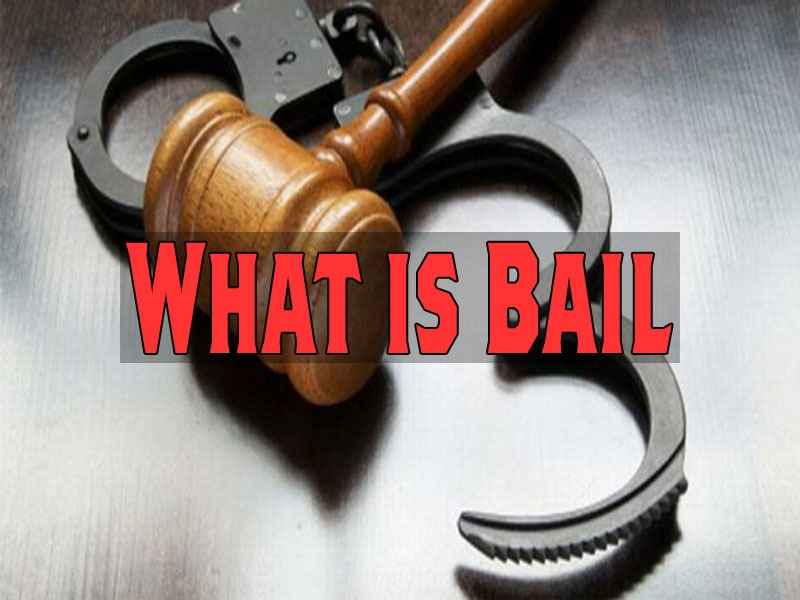Understanding Legal Ramifications

Navigating the legal complexities surrounding bail can be daunting. Understanding the procedures, types of bonds, and the role of bail bondsmen is crucial for a smooth and informed process. Different jurisdictions have varying approaches to bail, so a thorough understanding of local laws is essential. This section provides a comprehensive overview of these legal aspects.
Legal Procedures in Bail Applications
Bail procedures are designed to ensure the defendant’s return to court while allowing for their release from custody. These procedures typically involve the defendant appearing before a judge, who assesses the risk of flight or non-appearance. Factors considered often include the severity of the alleged crime, the defendant’s prior criminal history, and their ties to the community. A judge may set a specific monetary amount for release, which the defendant must meet to be released.
Types of Bail Bonds and Costs
Several types of bail bonds are available, each with its own associated costs. A cash bail requires the defendant or a third party to pay the full amount of the bail to the court. Surety bail, often facilitated by a bail bondsman, involves the bondsman posting the bail in exchange for a fee. The fee, typically a percentage of the bail amount, is the primary cost associated with a surety bond. Other types of bail, like property bail, may also be offered depending on the jurisdiction. The cost of a surety bond can vary significantly depending on the jurisdiction, the bail amount, and the specific bail bondsman. For example, a $10,000 bail bond might incur a fee of 10% or more, depending on the bail bondsman and the specific circumstances.
Role of a Bail Bondsman
A bail bondsman acts as an intermediary between the defendant and the court, facilitating the release of the defendant by posting bail. They are licensed professionals who assess the defendant’s risk of flight and ensure the defendant appears in court. Their responsibilities extend to monitoring the defendant’s whereabouts and ensuring compliance with court orders. A key aspect of their role is to maintain the safety of the community. The bondsman’s job is critical in ensuring the smooth running of the judicial system and minimizing the risk of defendants failing to appear in court.
Comparison of Bail Processes Across Jurisdictions
Bail procedures vary significantly across jurisdictions. In some states, cash bail is more common, while others favor surety bonds. The criteria for determining bail amounts may also differ, leading to varying experiences for defendants. Factors like the type of offense, the defendant’s prior criminal record, and the jurisdiction’s specific rules all contribute to the differences in bail procedures. For instance, a minor traffic violation might result in a significantly lower bail amount compared to a serious felony.
Typical Steps in a Bail Application Process
| Step | Description | Required Documents |
|---|---|---|
| 1. Arrest and Booking | The defendant is arrested and booked by law enforcement. | Arrest record, booking details |
| 2. Initial Court Appearance | The defendant appears before a judge for an initial hearing. | Identification documents, arrest record |
| 3. Bail Setting | The judge sets the amount of bail. | None; determined by the judge |
| 4. Bail Bond Arrangement (if applicable) | If the defendant chooses a surety bond, they will contact a bail bondsman. | Identification documents, arrest record |
| 5. Bond Payment | The bail is paid, either by the defendant or a bail bondsman. | Proof of payment, bond agreement |
| 6. Release | The defendant is released from custody. | Bail bond agreement |
This table Artikels the typical steps involved in a bail application process, highlighting the necessary documents at each stage.
Financial Aspects of Bail

Posting bail can involve significant financial implications, especially if you’re unfamiliar with the process. Understanding the various costs and payment options is crucial for navigating this aspect of the legal system effectively. The financial burden can vary depending on the specific circumstances of the case.
The cost of bail isn’t just the amount of money you pay initially. Hidden fees and potential consequences for non-appearance contribute to the overall financial commitment. A thorough understanding of these factors can help you make informed decisions and avoid unnecessary expenses.
Bail Bond Costs
Understanding the financial commitments associated with bail bonds is vital. The total cost isn’t simply the bail amount. Bail bondsmen charge a fee, typically a percentage of the bail amount. This fee covers their services in handling the bond.
Payment Options for Bail Bonds
Various payment options exist for bail bonds. Cash bail is a straightforward method, requiring the full bail amount upfront. However, for many, this is not a practical option. A bail bond agent can offer a more accessible solution, but it will include a fee.
- Cash Bail: This option involves paying the full bail amount in cash directly to the court. This is often the most straightforward approach but requires significant upfront funds.
- Bail Bonds: A bail bondsman can provide a surety bond, which is a contract guaranteeing the defendant’s appearance in court. The bondsman charges a fee, typically a percentage of the bail amount, for this service.
- Partial Payment: In certain cases, the court might allow partial payment of the bail amount. However, this is dependent on the specific circumstances and the judge’s discretion.
Fees Associated with Bail Bonds
Bail bondsmen typically charge a fee, usually expressed as a percentage of the bail amount. This fee is essential to cover their services, which include assessing the defendant’s risk and ensuring their appearance in court. This fee is often a significant cost associated with posting bail through a bondsman.
- Premium Fee: This is the most significant fee associated with a bail bond. It’s typically a percentage of the bail amount (e.g., 10% to 15%). The exact percentage can vary depending on the bondsman and the specific circumstances.
- Other Fees: Some bondsmen may charge additional fees, such as administrative costs or fees for background checks. These extra costs are usually transparent and clearly Artikeld in the contract.
Collateral Loss and Default
If the defendant fails to appear in court as scheduled, the collateral posted for the bail bond might be forfeited. This is a significant risk, and it’s essential to understand the potential consequences of non-appearance. The loss of collateral can lead to substantial financial penalties.
Comparison of Bail Bond Options
| Option | Cost | Details |
|---|---|---|
| Cash Bail | Full bail amount | Paid directly to the court; no fees, but requires significant funds. |
| Bail Bond | 10-15% of bail amount + other fees | Bondsman handles the bond, often more accessible than cash bail; includes risk assessment and court appearance monitoring. |
| Partial Payment | Negotiated with the court | Limited availability; dependent on judge’s discretion. |
Locating and Contacting Legal Professionals

Navigating the legal system during a critical time like someone’s arrest can be daunting. Understanding the complexities of bail procedures and the role of legal professionals is crucial for a smooth and informed process. A qualified legal representative can provide essential guidance, ensuring the accused’s rights are protected and the most favorable outcome is pursued.
Importance of Consulting with a Lawyer
A lawyer specializing in bail procedures offers invaluable support. They possess the expertise to navigate the intricacies of bail regulations, understand the specific charges, and assess the likelihood of success in court. Their knowledge of the local jurisdiction is also paramount, as bail laws and procedures can vary significantly from one region to another. A lawyer can analyze the strength of the prosecution’s case, identify potential weaknesses, and devise a strategy to achieve the best possible outcome.
Finding a Qualified Bail Bondsman
Finding a reputable bail bondsman is a crucial step. Several avenues can be explored. Online directories specializing in legal and financial services can provide a starting point. Networking with legal professionals and community members familiar with the local court system can also yield valuable leads. Direct inquiries with local bail bondsmen, often found through online searches or referrals, can also be effective.
Questions to Ask a Potential Bail Bondsman
Thorough questioning of potential bail bondsmen is essential. Critical questions to ask include the bondsman’s licensing and experience, fees associated with the bail bond, and the transparency of the agreement. Inquiring about their track record and understanding of the specific charges and court procedures will provide a clearer picture of their competency and reliability. Understanding the conditions attached to the bond, such as travel restrictions or reporting requirements, is equally important. A good bondsman will be transparent and forthcoming in answering these questions.
Hiring a Lawyer Specializing in Bail Procedures
Hiring a lawyer specialized in bail procedures involves a systematic approach. Initial contact can be made through online searches or referrals from trusted sources. Shortlisting candidates based on their experience and reputation is essential. Following up with a consultation to discuss the specific circumstances of the case is crucial. Reviewing their fee structure and agreement terms is vital to ensure mutual understanding and alignment. Prioritizing lawyers with a proven track record of success in similar cases is prudent.
Resources for Legal Aid and Bail Bond Services
| Resource Type | Contact Information | Services Offered |
|---|---|---|
| Legal Aid Organizations | (Specific organizations vary, research local options) | Free or low-cost legal assistance for those who qualify. This may include advice on bail procedures. |
| Bar Associations | (Specific bar associations vary, research local options) | Referrals to qualified attorneys, including those specializing in bail procedures. May also provide resources for legal aid. |
| Local Courts | (Specific court information varies, research local options) | Information about court procedures, rules, and resources for finding legal representation. |
| Online Legal Directories | (e.g., Avvo, Martindale-Hubbell) | Profiles of attorneys, including those specializing in bail procedures, with ratings and reviews. |
Gathering Necessary Documents

A successful bail application hinges on the completeness and accuracy of the submitted documents. These documents serve as proof of your relationship with the accused, your financial capacity, and your commitment to ensuring their appearance in court. Thorough preparation ensures a smoother process and increases the likelihood of a positive outcome.
Required Documents for Bail Application
A comprehensive list of documents is essential for a successful bail application. Each document provides crucial information about the applicant, the accused, and the financial capacity supporting the bail. Failure to submit any necessary document could delay or jeopardize the application. Careful attention to detail in preparing these documents is critical.
- Identification Documents: These documents verify the applicant’s identity and legal standing. They often include government-issued photo identification, such as a passport, driver’s license, or national ID card. The applicant’s full name, date of birth, and address must match the information on the identification document. The accuracy of these details is paramount to the application process.
- Proof of Relationship (if applicable): If the applicant is a family member or close associate of the accused, documentation substantiating this relationship is often required. This could include marriage certificates, birth certificates of shared children, or other legal documents demonstrating a close personal connection. These documents verify the applicant’s claim to have a genuine interest in the accused’s well-being and their commitment to ensuring their attendance in court.
- Financial Documents: Demonstrating financial capacity is critical for bail applications. This typically includes proof of income, such as pay stubs, bank statements, tax returns, or employment contracts. These documents provide evidence of the applicant’s ability to meet the financial obligations associated with the bail. The accuracy of the financial information is essential.
- Supporting Statements/Letters: Personal statements or letters of support from character witnesses can provide additional assurance to the court about the applicant’s trustworthiness and commitment to ensuring the accused’s court appearance. These letters should Artikel the applicant’s familiarity with the accused, their understanding of the charges, and their commitment to ensuring the accused’s presence in court. These statements add a personal touch to the application and can significantly influence the court’s decision.
- Legal Documents (if applicable): Any existing legal documents, such as court orders or previous bail agreements, might be relevant to the current application. These documents provide context and history related to the accused and their past interactions with the legal system. They can assist in providing a comprehensive picture of the case.
Importance of Accurate Information
Accurate information is crucial throughout the bail application process. Inaccuracies can lead to delays, rejections, or even legal repercussions. Providing false or misleading information is a serious offense. Ensuring the accuracy of all documents is vital to a successful outcome. Double-checking all details is paramount.
Obtaining Unavailable Documents
If certain documents are unavailable, alternative methods for obtaining them must be explored. This might involve contacting previous employers for pay stubs, contacting banks for account statements, or seeking assistance from legal professionals for help in acquiring necessary documents. Proactive steps must be taken to obtain these documents if possible.
Table of Required Documents
| Document Type | Purpose | Description |
|---|---|---|
| Identification Documents | Verify applicant’s identity | Passport, driver’s license, national ID card |
| Proof of Relationship | Demonstrate applicant’s connection to the accused | Marriage certificate, birth certificates, etc. |
| Financial Documents | Prove financial capacity | Pay stubs, bank statements, tax returns |
| Supporting Statements/Letters | Provide character references | Letters from witnesses supporting the applicant |
| Legal Documents | Provide context | Previous court orders, bail agreements |
Alternatives to Bail: How To Bail Someone Out Of Prison

Beyond posting bail, several alternatives exist for individuals facing potential imprisonment. These options can be crucial for those who lack the financial means to secure traditional bail. Understanding these alternatives can help navigate the legal process more effectively and potentially reduce the financial burden on the accused.
Alternative arrangements to traditional bail are often designed to ensure the defendant’s appearance in court while minimizing the financial strain. These arrangements may involve different conditions and limitations, and each option has its own set of eligibility requirements. Careful consideration of these factors is crucial when exploring alternative solutions.
Release on Recognizance (ROR)
Release on Recognizance (ROR) is a common alternative to bail. It allows individuals to be released from custody without posting money. This option is based on the presumption that the defendant will appear in court, and that the defendant is unlikely to flee.
The process for applying for ROR involves a formal request to the court, often made by the defendant or their legal representative. The court considers various factors, including the nature of the alleged crime, the defendant’s criminal history, and the strength of the evidence against them. A judge may impose conditions to ensure the defendant’s appearance, such as regular check-ins with a probation officer or restrictions on travel.
Other Alternative Release Options
Other alternative release options can be available depending on the circumstances of the case. These options include:
- Unsecured Bond: This option allows the defendant to be released without providing any money upfront, but the defendant is still liable for the bond amount if they fail to appear in court. This option can be attractive to those who lack the financial resources for a traditional bail, but it does come with a significant risk.
- Conditional Release: This alternative involves the defendant agreeing to specific conditions, such as attending regular therapy sessions or staying away from certain locations. The defendant’s release depends on their adherence to these conditions.
- Third-Party Custody: A responsible individual can agree to be held accountable for the defendant’s appearance in court. This person often provides a pledge or collateral to ensure the defendant’s compliance with court orders. This alternative can provide a viable option when other alternatives are not suitable.
Comparison of Bail Alternatives
| Alternative | Description | Eligibility Requirements |
|---|---|---|
| Release on Recognizance (ROR) | Release from custody without posting money, based on the defendant’s promise to appear in court. | Generally, no significant criminal history, and the nature of the crime does not suggest a high likelihood of flight. |
| Unsecured Bond | Release without providing money upfront, but the defendant is responsible for the bond amount if they fail to appear. | Similar to ROR, with considerations regarding the defendant’s risk to flee. |
| Conditional Release | Release subject to specific conditions imposed by the court. | May be appropriate for defendants with a history of compliance or for less serious offenses. |
| Third-Party Custody | Release with a responsible individual agreeing to ensure the defendant’s appearance. | Requires a reliable and trustworthy third party who can provide assurance of the defendant’s compliance. |
Applying for Release on Recognizance (ROR)
Applying for release on recognizance typically involves the defendant’s attorney presenting arguments to the court. The attorney will argue for the defendant’s reliability and ability to appear in court, citing relevant factors like employment history, community ties, and the strength of the case against the defendant.
Benefits and Drawbacks of Alternatives
Different alternative release options offer varying benefits and drawbacks.
- ROR: The significant benefit is the lack of financial burden. However, the risk of not appearing in court remains. The defendant must be trustworthy and understand the legal obligations.
- Unsecured Bond: This alternative offers financial relief, but it involves significant risk for non-compliance. The potential financial penalty can be substantial.
- Conditional Release: It can provide a path to freedom while ensuring the defendant’s compliance with court orders. However, failure to comply can lead to arrest and further legal complications.
- Third-Party Custody: This can provide a suitable option for defendants lacking other suitable arrangements. The third party must have the financial capacity and responsibility.
Illustrative Case Studies

Successfully navigating the bail process hinges on meticulous preparation and a nuanced understanding of the legal system. Factors such as the severity of the alleged crime, the defendant’s prior record, and the strength of the prosecution’s case all play crucial roles in the court’s decision. This section provides illustrative case studies, highlighting both successful and unsuccessful bail outcomes to illuminate the complexities involved.
Successful Bail Acquisition
A young woman, facing charges of shoplifting, demonstrated a strong case for bail. She had no prior criminal record, a stable employment history, and a supportive family willing to provide substantial financial backing. The prosecutor’s case rested primarily on circumstantial evidence, and the judge, considering her circumstances, granted bail. This outcome underscores the importance of presenting a compelling picture of the defendant’s character and ties to the community.
Bail Denied
In a contrasting case, a man with a lengthy history of violent offenses, facing charges of aggravated assault, had his bail request denied. The judge cited the severity of the charges, the defendant’s prior convictions, and the potential danger he posed to the community. This outcome exemplifies the weight given to past behavior and the public safety concerns when evaluating bail applications.
Detailed Case Study of Successful Bail Bond Process
A successful bail bond process involves a series of steps. A defendant, charged with a drug-related offense, engaged a reputable bail bondsman. The bondsman processed the necessary paperwork, including the defendant’s personal information, the details of the charges, and a copy of the court order. The bondsman verified the defendant’s financial standing to ensure a credible bond amount. Simultaneously, the bondsman secured a surety bond, a financial guarantee to the court that the defendant would appear for all court proceedings. The defendant signed the necessary paperwork, agreeing to the terms of the bond. Finally, the court approved the bail bond, releasing the defendant into the custody of the bail bondsman. The defendant was able to post the required collateral and was released.
Circumstances Surrounding Successful/Failed Bail
The successful bail outcome in the shoplifting case hinged on the defendant’s clean record, stable employment, and a strong support network. Conversely, the failed bail request in the aggravated assault case stemmed from the defendant’s documented history of violence and the judge’s concerns about public safety. These cases highlight the nuanced considerations that judges take into account during bail hearings.
Challenges in Securing Bail in a Specific Legal Situation, How to bail someone out of prison
“Securing bail in cases involving complex legal issues, such as alleged financial fraud with intricate transactions, can prove significantly challenging due to the substantial evidence required to establish the defendant’s innocence and the necessity of demonstrating a low risk of flight.”
FAQ Overview
How to bail someone out of prison – What are the typical fees associated with a bail bond?
Bail bond fees vary depending on the jurisdiction and the amount of bail. They are typically a percentage of the total bail amount, often ranging from 10% to 15%. Additional fees may also apply.
What are some alternative arrangements besides bail?
Alternatives to bail can include release on recognizance (ROR), which allows release without a financial guarantee, or other conditions set by the court. These alternatives may have specific eligibility requirements and limitations.
How long does the bail process typically take?
The time frame for the bail process varies significantly depending on factors such as the complexity of the case, court schedules, and the availability of legal professionals. It’s best to contact the relevant court for the most up-to-date information.
What documents are typically needed for a bail application?
Required documents can include identification, proof of residency, and financial statements, among others. The specific documents may vary depending on the jurisdiction and the nature of the case.